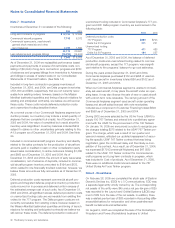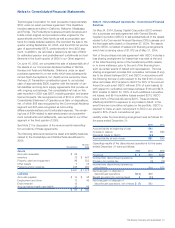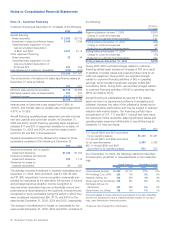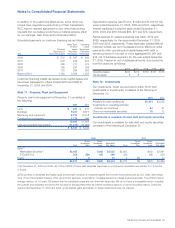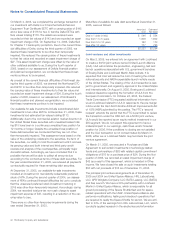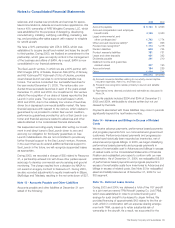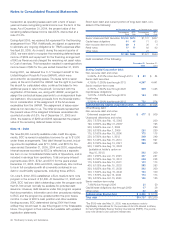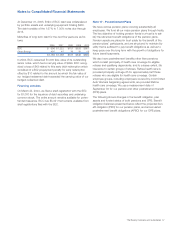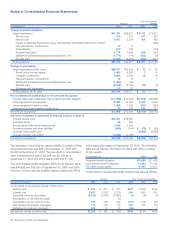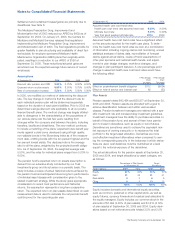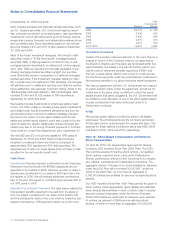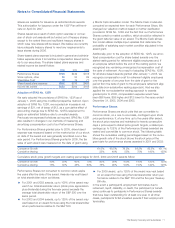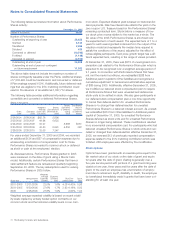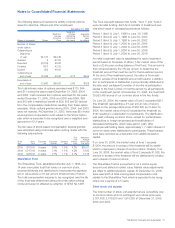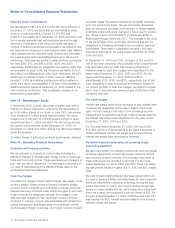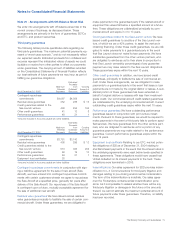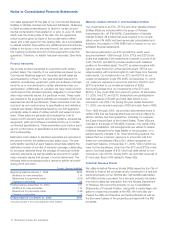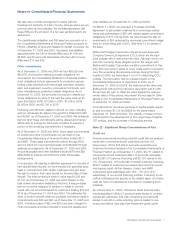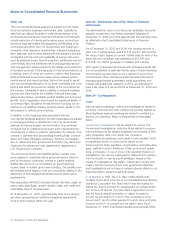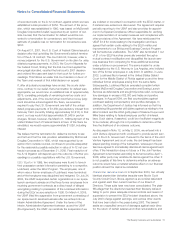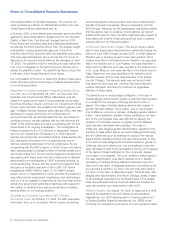Boeing 2005 Annual Report Download - page 72
Download and view the complete annual report
Please find page 72 of the 2005 Boeing annual report below. You can navigate through the pages in the report by either clicking on the pages listed below, or by using the keyword search tool below to find specific information within the annual report.
Notes to Consolidated Financial Statements
at September 30, 2005 and 2004.
Debt includes domestic and international debt securities, such
as U.S. Treasury securities, U.S. Government agency securi-
ties, corporate bonds and commercial paper; cash equivalents;
investments in bond derivatives such as bond futures, options,
swaps and currency forwards; and redeemable preferred stock
and convertible debt. Bond derivatives based on net notional
amounts totaled 3.9% and 4.6% of plan assets at September
30, 2005 and 2004.
Most of the trusts’ investment managers, who invest in debt
securities, invest in “To-Be-Announced” mortgage-backed
securities (TBA). A TBA represents a contract to buy or sell
mortgage-backed securities to be delivered at a future agreed
upon date. TBAs are deemed economically equivalent to pur-
chasing mortgage-backed securities outright, but are often
more attractively priced in comparison to traditional mortgage-
backed securities. If the investment manager wishes to main-
tain a certain level of investment in TBA securities, the manager
will sell them prior to settlement and buy new TBAs for another
future settlement; this approach is termed “rolling”. Most of the
TBA securities held were related to TBA roll strategies. Debt
included $1,464 and $1,632 related to TBA securities at
September 30, 2005 and 2004.
Real estate includes investments in private real estate invest-
ments. The Other category includes private equity investments
and hedge funds. Actual investment allocations vary from tar-
get allocations due to periodic investment strategy changes
and due to the nature of some asset classes such as real
estate and private equity where it could take a period of a few
years to reach the targets. Additionally, actual and target allo-
cations vary due to the timing of benefit payments or contribu-
tions made on or near the measurement date, September 30.
We held $82 and $72 in trust fund assets for OPB plans at
September 30, 2005 and 2004. Most of these funds are
invested in a balanced index fund which is comprised of
approximately 60% equities and 40% debt securities. The
expected rate of return on these assets does not have a mate-
rial effect on the net periodic benefit cost.
Cash Flows
Contributions Required pension contributions under Employee
Retirement Income Security Act (ERISA) regulations are not
expected to be material in 2006. However, we plan to make a
discretionary contribution to our plans of $500 (pre-tax) in the
first quarter of 2006. We will evaluate additional contributions
later in the year. We expect to contribute approximately $25 to
our OPB plans in 2006.
Estimated Future Benefit Payments The table below reflects the
total pension benefits expected to be paid from the plans or
from our assets, including both our share of the benefit cost
and the participants’ share of the cost, which is funded by par-
ticipant contributions. OPB payments reflect our portion only.
Other
Postretirement
Pensions Benefits
2006 $2,372 $3,529
2007 2,436 563
2008 2,495 586
2009 2,551 610
2010 2,614 636
2011-2015 14,527 3,423
Termination Provisions
Certain of the pension plans provide that, in the event there is a
change in control of the Company which is not approved by
the Board of Directors and the plans are terminated within five
years thereafter, the assets in the plan first will be used to pro-
vide the level of retirement benefits required by ERISA, and
then any surplus will be used to fund a trust to continue pres-
ent and future payments under the postretirement medical and
life insurance benefits in our group insurance benefit programs.
We have an agreement with the U.S. Government with respect
to certain pension plans. Under the agreement, should we ter-
minate any of the plans under conditions in which the plan’s
assets exceed that plan’s obligations, the U.S. Government will
be entitled to a fair allocation of any of the plan’s assets based
on plan contributions that were reimbursed under U.S.
Government contracts.
401(k)
We provide certain defined contribution plans to all eligible
employees. The principal plans are the Company-sponsored
401(k) plans and an unfunded plan for unused sick leave. The
expense for these defined contribution plans was $483, $468
and $464 in 2005, 2004 and 2003, respectively.
Note 18 - Share-Based Compensation and Deferred
Stock Compensation
On April 28, 2003, the shareholders approved The Boeing
Company 2003 Incentive Stock Plan (2003 Plan). The 2003
Plan permits awards of incentive stock options, nonqualified
stock options, restricted stock, stock units, Performance
Shares, performance units and other incentives to our employ-
ees, officers, consultants and independent contractors. The
aggregate number of shares of our stock available for issuance
under the 2003 Plan will not exceed 30,000,000. Under the
terms of the 2003 Plan, no more than an aggregate of
6,000,000 shares are available for issuance as restricted stock
awards.
Our 1997 Incentive Stock Plan (1997 Plan) permits the grant of
stock options, stock appreciation rights (SARs) and restricted
stock awards (denominated in stock or stock units) to employ-
ees and contract employees. Under the terms of the plan,
64,000,000 shares are authorized for issuance upon exercise
of options, as payment of SARs and as restricted stock
awards, of which no more than an aggregate of 6,000,000
70 The Boeing Company and Subsidiaries


